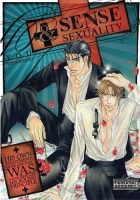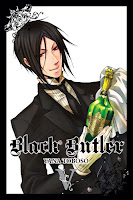My News and Reviews
Despite being in Toronto for the majority of last week for the Toronto Comic Arts Festival (which I should hopefully have a write-up about soon), I still managed to post a few things here at Experiments in Manga. For those interested in what sorts of manga and other books make their way onto my shelves, April’s Bookshelf Overload is now available. The feature used to be posted fairly early on in the month, but at least for the time being it’s more likely to appear sometime in the second week as I’m following a more relaxed posting schedule. Last week I also reviewed Philip K. Dick’s award-winning novel The Man in the High Castle which explores an alternate history in which Germany and Japan won the Second World War and occupy most of what was the United States. It’s a fascinating, thought-provoking, chilling, and frankly terrifying work.
A few interesting things that I came across online last week while I wasn’t wandering around Toronto: The lead lawyer of Rokudenashiko’s legal team wrote a nice summary and explanation of the recent verdict in her obscenity trial, including the next steps that will be taken in the case. (I reviewed Rokudenashiko’s What Is Obscenity? a couple of weeks ago; the manga is excellent, and I was thrilled to have the chance to meet Rokudenashiko at TCAF.) Over at Publishers Weekly, Brigid Alverson writes about Hachette and Kadokawa’s recently announced partnership and what it means for Yen Press. Finally, Leah Zoller and Kathryn Hemmann have started to post a series of articles at The Lobster Dance based on their panel The Sparkling World of 1970s Shojo Manga, which should be fantastic.
Quick Takes
 Noragami: Stray Stories, Volume 1 by Adachitoka. Even though I have fallen behind in reading the main series, I have been enjoying Adachitoka’s Noragami. I’m apparently not the only one as the manga has been doing quite well for Kodansha, enough so that the publisher also licensed Stray Stories, a multi-volume series of Noragami side stories. For the most part, the short manga of Stray Stories don’t appear to rely on the main Noragami storyline although it is assumed that readers are at least already vaguely familiar with the manga’s characters and basic premise. So far, Stray Stories reminds me a bit of Noragami‘s earlier, more episodic nature before the series’ overarching plot began to take precedence. The short manga collected in Stray Stories also tend to be more comedic than serious, which I greatly enjoyed. The first volume was a lot of fun, and I’m glad that there will be more side stories to come. Stray Stories allows Adachitoka to expand on the world and characters of Noragami in ways that wouldn’t make sense in the main series but that are still enjoyable in their own right.
Noragami: Stray Stories, Volume 1 by Adachitoka. Even though I have fallen behind in reading the main series, I have been enjoying Adachitoka’s Noragami. I’m apparently not the only one as the manga has been doing quite well for Kodansha, enough so that the publisher also licensed Stray Stories, a multi-volume series of Noragami side stories. For the most part, the short manga of Stray Stories don’t appear to rely on the main Noragami storyline although it is assumed that readers are at least already vaguely familiar with the manga’s characters and basic premise. So far, Stray Stories reminds me a bit of Noragami‘s earlier, more episodic nature before the series’ overarching plot began to take precedence. The short manga collected in Stray Stories also tend to be more comedic than serious, which I greatly enjoyed. The first volume was a lot of fun, and I’m glad that there will be more side stories to come. Stray Stories allows Adachitoka to expand on the world and characters of Noragami in ways that wouldn’t make sense in the main series but that are still enjoyable in their own right.
 Real Account, Volume 1 written by Okushou and illustrated by Shizumu Watanabe. I’ll admit, I actually wasn’t expecting all that much from Real Account, so I was a little surprised by how much liked the first volume of the series even if there were a few things that didn’t quite work and even if there was at least one minor plot hole. Quite a few manga seem to have come out over the last few years with a similar basic premise in which a group of people find themselves trapped in an online environment where they must survive. If they die onlie, they will die real world as well. In the case of Real Account, that online environment is greatly influenced by social media and the users’ survival depends on them having at least one follower. The titular “Real Account” is something closely akin to Twitter with a few additional elements, like games, mixed in. Some of the deadly games those who are being held hostage are forced to play are actually quite clever and highly psychological, relying on the unpredictable nature of human relationships when self-preservation is on the line. At this point in the series it’s still unclear who is behind it all and what their motivations are, but there is definite and not particularly subtle social commentary being made.
Real Account, Volume 1 written by Okushou and illustrated by Shizumu Watanabe. I’ll admit, I actually wasn’t expecting all that much from Real Account, so I was a little surprised by how much liked the first volume of the series even if there were a few things that didn’t quite work and even if there was at least one minor plot hole. Quite a few manga seem to have come out over the last few years with a similar basic premise in which a group of people find themselves trapped in an online environment where they must survive. If they die onlie, they will die real world as well. In the case of Real Account, that online environment is greatly influenced by social media and the users’ survival depends on them having at least one follower. The titular “Real Account” is something closely akin to Twitter with a few additional elements, like games, mixed in. Some of the deadly games those who are being held hostage are forced to play are actually quite clever and highly psychological, relying on the unpredictable nature of human relationships when self-preservation is on the line. At this point in the series it’s still unclear who is behind it all and what their motivations are, but there is definite and not particularly subtle social commentary being made.
 Sense & Sexuality by You Higashino. Originally released in English in print as part of Media Blaster’s Kitty Media line, Sense & Sexuality is now available digitally from Sublime Manga. I haven’t come across very many manga that take place during Japan’s Taishō Era, but it’s a really interesting time period in the country’s history and one of the reasons Higashino’s boys’ love one-shot Sense & Sexuality was first brought to my attention. The manga follows the sexual conquests of Hanamura and Takakura, two close friends from noble families whose lives are filled with decadence, leisure, and hedonism. They have turned their romances into a game, betting on who will be the first to bed the various attractive young men they have identified as their targets. Eventually though, their sights are set upon each other. For the most part, Sense & Sexuality is fairly episodic. There’s just enough story to hold it all together, but what little plot there is simply provides the excuses needed for the manga’s plentiful and explicit sex. High literature it is not, nor does it need to be. I really liked Sense and Sexuality‘s setting, the characters have a bit more depth to them than it initially seems, and the manga can be surprisingly humorous even though I wouldn’t necessarily describe it as a comedy.
Sense & Sexuality by You Higashino. Originally released in English in print as part of Media Blaster’s Kitty Media line, Sense & Sexuality is now available digitally from Sublime Manga. I haven’t come across very many manga that take place during Japan’s Taishō Era, but it’s a really interesting time period in the country’s history and one of the reasons Higashino’s boys’ love one-shot Sense & Sexuality was first brought to my attention. The manga follows the sexual conquests of Hanamura and Takakura, two close friends from noble families whose lives are filled with decadence, leisure, and hedonism. They have turned their romances into a game, betting on who will be the first to bed the various attractive young men they have identified as their targets. Eventually though, their sights are set upon each other. For the most part, Sense & Sexuality is fairly episodic. There’s just enough story to hold it all together, but what little plot there is simply provides the excuses needed for the manga’s plentiful and explicit sex. High literature it is not, nor does it need to be. I really liked Sense and Sexuality‘s setting, the characters have a bit more depth to them than it initially seems, and the manga can be surprisingly humorous even though I wouldn’t necessarily describe it as a comedy.









